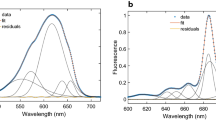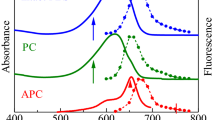Abstract
The aim of this paper is to review and discuss the results obtained by fluorescence and absorption spectroscopy of bacterial chromatophores excited with picosecond pulses of varying power and intensity. It was inferred that spectral and kinetic characteristics depend essentially on the intensity, the repetition rate of the picosecond excitation pulses as well as on the optical density of the samples used. Taking the different experimental conditions properly into account, most of the discrepancies between the fluorescence and absorption measurements can be solved. At high pulse repetition rate (>106 Hz), even at moderate excitation intensities (1010–1011 photons/cm2 per pulse), relatively long-lived triplet states start accumulating in the system. These are efficient (as compared to the reaction centers) quenchers of mobile singlet excitations due to singlet-triplet annihilation. The singlet-triplet annihilation rate constant in Rhodospirillum rubrum was determined to be equal to 10-9 cm3 s-1. At fluences >1012 photons/cm2 per pulse singlet-singlet annihilation must be taken into account. Furthermore, in the case of high pulse repetition rates, triplet-triplet annihilation must be considered as well. From an analysis of experimental data it was inferred that the singlet-singlet annihilation process is probably migration-limited. If this is the case, one has to conclude that the rate of excitation decay in light-harvesting antenna at low pumping intensities is limited by the efficiency of excitation trapping by the reaction center. The influence of annihilation processes on spectral changes is also discussed as is the potential of a local heating caused by annihilation processes. The manifestation of spectral inhomogeneity of light-harvesting antenna in picosecond fluorescence and absorption kinetics is analyzed.
Similar content being viewed by others
Abbreviations
- LHA:
-
light-harvesting antenna
- RC:
-
reaction center
References
Agranovich VM and Efremov NA (1980) Luminescence spectra of noncoherent Frenkel excitons at high pumping levels. Soviet Physics-Solid State 22: 583–588
Agranovich VM and Galanin MD (1982) Electronic Excitation Energy Transfer in Condensed Matter. Amsterdam: North-Holland Publishing Co (Modern Problems in Condensed Matter Sciencies, Vol 3)
Bakker JGC, vanGrondelle R and denHollander WTF (1983) Trapping, loss and annihilation of excitations in photosynthetic systems. II. Experiments with the purple bacteria Rhodospirillum rubrum and Rhodopseudomonas capsulata. BBA 725: 508–518
Bergstrom H, vanGrondelle R and Sundstrom V (1989) Characterization of excitation energy trapping in photosynthetic purple bacteria at 77 K. FEBS Lett 250: 503–508
Borisov AYu, Gadonas RA, Danielius RV, Piskarskas AS and Razjivin AP (1982) Minor component B-905 of light-harvesting antenna in Rhodospirillum rubrum chromatophores and the mechanism of singlet-singlet annihilation as studied by difference selective picosecond spectroscopy. FEBS Lett 138: 25–28
Borisov AYu, Gadonas RA, Danielius RV, Piskarskas AS, Razjivin AP and Rotomskis RI (1984) Study of kinetics of excited state deactivation in antenna of chromatophores from Rhodospirillum rubrum studied by picosecond difference spectrophotometry. Biofizika 29: 398–402, in Russian
Borisov AYu, Freiberg AM, Godik VI, Rebane KK and Timpmann KE (1985) Kinetics of picosecond bacteriochlorophyll luminescence in vivo as a function of the reaction center state. BBA 807: 221–229
Breton J, Geacintov NE and Swenberg CE (1979) Quenching of fluorescence by triplet states in chloroplasts. BBA 548: 616–635
Campillo AJ and Shapiro SL (1978) Picosecond fluorescence studies of exciton migration and annihilation in photosynthetic systems. Photochemistry and Photobiology 28: 975–989
Cogdell RJ and Frank HA (1987) How carotenoids function in photosynthetic bacteria. BBA 895: 63–80
Danielius R and Razjivin A (1988) New data on the state of excitation in the light-harvesting antenna and their trapping by reaction centers. In: Rudzikas Z, Piskarskas A and Baltramiejunas R (eds) Proc of UPS Topical Meeting, pp 231–239. Singapore: World Scientific Corporation
denHollander WTF, Bakker JGC and vanGrondelle R (1983) Trapping, loss and annihilation of excitations in a photosynthetic system. I. Theoretical aspects. BBA 725: 492–507
Freiberg A (1986) Primary processes of photosynthesis studied by fluorescence spectroscopy methods. Laser Chem 6: 233–252
Freiberg A, Godik VI and Timpmann K (1984) Excitation energy transfer in bacterial photosynthesis studied by picosecond laser spectrochronography. In: Sybesma C (ed) Advances in Photosynthesis Research, Vol 1, pp 45–48. Dordrecht: Martinus Nijhoff/Dr W Junk Publishers
Freiberg A, Godik VI and Timpmann K (1987) Spectral dependence of the fluorescence life time of Rhodospirillum rubrum. Evidence for inhomogeneity of B880 absorption. In: Biggins J (ed) Progress in Photosynthesis Research, Vol 1, pp 45–48. Dordrecht: Martinus Nijhoff Publishers
Freiberg A, Godik VI, Pullerits T and Timpmann K (1989) Picosecond dynamics of directed excitation transfer in spectrally heterogeneous light-harvesting antenna of purple bacteria. BBA 973: 93–104
Freiberg A, Godik VI, Pullerits T and Timpmann K (1990a) Excitation transport and quenching in photosynthetic bacteria at normal and cryogenic temperatures. In: Baltscheffsky M (ed) Current Research in Photosynthesis, Vol II, pp 157–160. Dordrecht: Kluwer Academic Publishers
Freiberg A, Pullerits T and Timpmann K (1990b) Time-resolved fluorescence spectroscopy of photosynthetic membranes. Experiment and model simulations. In: Lakowicz JR (ed) Time-resolved Laser Spectroscopy in Biochemistry II Proc SPIE, Vol 1204, part 2, pp 727–735. Bellingham, Washington: SPIE Publishers
Geacintov NE and Breton J (1977) Exciton annihilation in the two photosystems in chloroplasts at 100 K. Biophys J 17: 1–15
Geacintov NE and Breton J (1982) Exciton annihilation and nonlinear high-intensity excitation effects. In: Alfano RR (ed) Biological Events Probed by Ultrafast Laser Spectroscopy, pp 178–191. New York: Academic Press
Geacintov NE, Swenberg CE, Campillo AJ, Hyer RC, Shapiro SL and Winn KR (1978) A picosecond pulse train study of exciton dynamics in photosynthetic membranes. Biophys J 24: 347–359
Godik VI, Timpmann KE and Freiberg AM (1988) Spectral inhomogeneity of the bacteriochlorophyll absorption band in Rhodospiril lumrubrum obtained by fluorescence pico-second spectroscopy data. Dokl AN SSSR 298: 1469–1473
Holzwarth AR (1987) Picosecond fluorescence spectroscopy and energy transfer in photosynthetic antenna pigments. In: Barber J (ed) The Light Reactions, pp 95–157. Amsterdam: Elsevier Science Publishers
Junge W and Jackson JB (1982) Electrochemical difference potential formation in photosynthetic membranes. In: Govindjee (ed) Photosynthesis, Vol 2, pp 65–135. New York: Acad Press
Kenkre VM and Knox RS (1976) Optical spectra and exciton coherence. J Luminescence 12: 187–194
Kingma H (1983) Thesis, State University of Leiden
Kramer HJM, Penoyer JD, vanGrondelle R, Westerhuis WHJ, Niedermann A and Amesz J (1984) Low-temperature optical properties and pigment organization of the B875 light-harvesting bacteriochlorophyll-protein complex of purple photosynthetic bacteria. BBA 767: 335–344
Kudzmauskas S, Valkunas L and Borisov AYu (1983) A theory of excitation transfer in photosynthetic units. J Theor Biol 105: 13–23
Kudzmauskas S, Liuolia V, Trinkunas G and Valkunas L (1985) Nonlinear phenomena in chromatophores of photosynthetic bacteria excited by picosecond laser pulses. Phys Lett 111A: 378–381
Kudzmauskas S, Liuolia V, Trinkunas G and Valkunas L (1986) Minor component of the difference absorption spectra of photosynthetic bacteria chromatophores and nonlinear effect during excitation. FEBS Lett 194: 205–209
Kudzmauskas S, Liuolia V, Trinkunas G and Valkunas L (1988) Nonlinear phenomena in picosecond spectroscopy of photosynthetic membranes. In: Rudzikas Z, Piskarskas A and Baltramiejunas R (eds) Proc of UPS Topical Meeting, pp 248–256. Singapore: World Scientific Corporation
Mineyev AP and Razjivin AP (1987) Statistics of the photon distribution in the set of photosynthetic antenna domains. FEBS Lett 223: 187–190
Monger TG and Parson WW (1977) Singlet-triplet fusion in Rhodopseudomonas sphaeroides chromatophores. A probe of the organization of the photosynthetic apparatus. BBA 460: 393–407
Nuijs AM, vanGrondelle R, Joppe HLP, vanBochove AC and Duysens LNM (1985) Singlet and triplet excited carotenoid and antenna bacteriochlorophyll of the photosynthetic purple bacterium Rhodospirillum rubrum as studied by picosecond absorbance difference spectroscopy. BBA 810: 94–105
Paillotin G, Swenberg CE, Breton J and Geacintov NE (1979) Analysis of picosecond laser-induced fluorescence phenomena in photosynthetic membranes utilizing a master equation approach. Biophys J 25: 513–533
Pearlstein RM (1982) Exciton migration and trapping in photosynthesis. Photochem Photobiol 35: 835–844
Rademaker H and Hoff AJ (1981) The balance between primary forward and back reactions in bacterial photosynthesis. Biophys J 34: 325–344
Renger G and Wolf CH (1977) Further evidence for dissipative energy migration via triplet states in photosynthesis. The protective mechanism of carotenoids in Rhodopseudomonas sphaeroides chromatophores. BBA 460: 47–57
Rijgersberg CR, vanGrondelle R and Amesz J (1980) Energy transfer and bacteriochlorophyll fluorescence in purple bacteria at low temperature. BBA 592: 53–64
Sunström V, vanGrondelle R, Bergström H, Åkesson E and Gillbro T (1986) Excitation energy transport in the bacteriochlorophyll antenna systems of Rhodospirillum rubrum and Rhodobacter sphaeroides, studied by low-intensity picosecond absorption spectroscopy. BBA 851: 431–446
Valkunas L (1986) Influence of structure heterogeneity on energy migration in photosynthesis. Laser Chem 6: 253–267
Valkunas L (1989) Nonlinear processes in picosecond spectroscopy of photosynthetic systems. In: Spasov AY (ed) Proc of the 5 Int School on Quantum Electronics ‘Lasers-Physics and applications’, pp 541–560. Singapore: World Scientific Corporation
Valkunas L, Kudzmauskas S and Liuolia V (1986) Noncoherent migration of excitation in impure molecular structures. Sov Phys-Coll (Liet Fiz Rink) 26: 1–11
vanGrondelle R (1985) Excitation energy transfer, trapping and annihilation in photosynthetic systems. BBA 811: 147–195
vanGrondelle R, Bergström H, Sundström V and Gillbro T (1987) Energy transfer within the bacteriochlorophyll of purple bacteria at 77 K, studied by picosecond absorption recovery. BBA 894: 313–326
Visscher KJ, Bergström H, Sundström V, Hunter CN and vanGrondelle R (1989) Temperature dependence of energy transfer from the long wavelength antenna BChl-896 to the reaction center in Rhodospirillum rubrum, Rhodobacter sphaeroides (w.t. and M21 mutant) from 77 to 177K, studied by picosecond absorption spectroscopy. Photosynth Res 22: 211–217
Vos M, vanGrondelle R, van derKooij FW, van derPoll D, Amesz J and Duysens LNM (1986) Singlet-singlet annihilation at low temperatures in antenna of purple bacteria. BBA 850: 501–512
Woodbury N and Bittersmann E (1989) Time-resolved measurements of fluorescence from the photosynthetic membranes of Rhodobacter capsulatus and Rhodospirillum rubrum. In: Balcheffsky M (ed) Current Research in Photosynthesis, Vol II, pp 165–168. Dordrecht: Kluwer Academic Publishers
Author information
Authors and Affiliations
Rights and permissions
About this article
Cite this article
Valkunas, L., Liuolia, V. & Freiberg, A. Picosecond processes in chromatophores at various excitation intensities. Photosynth Res 27, 83–95 (1991). https://doi.org/10.1007/BF00033248
Received:
Accepted:
Issue Date:
DOI: https://doi.org/10.1007/BF00033248




